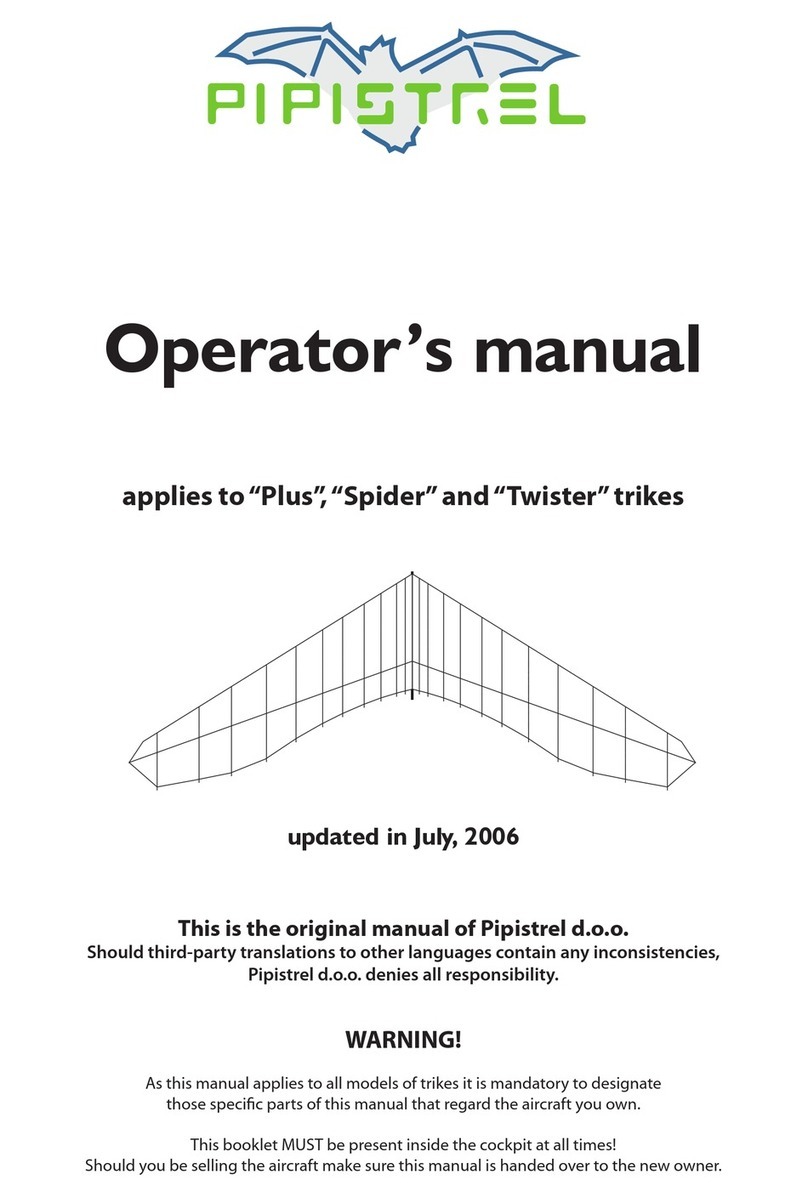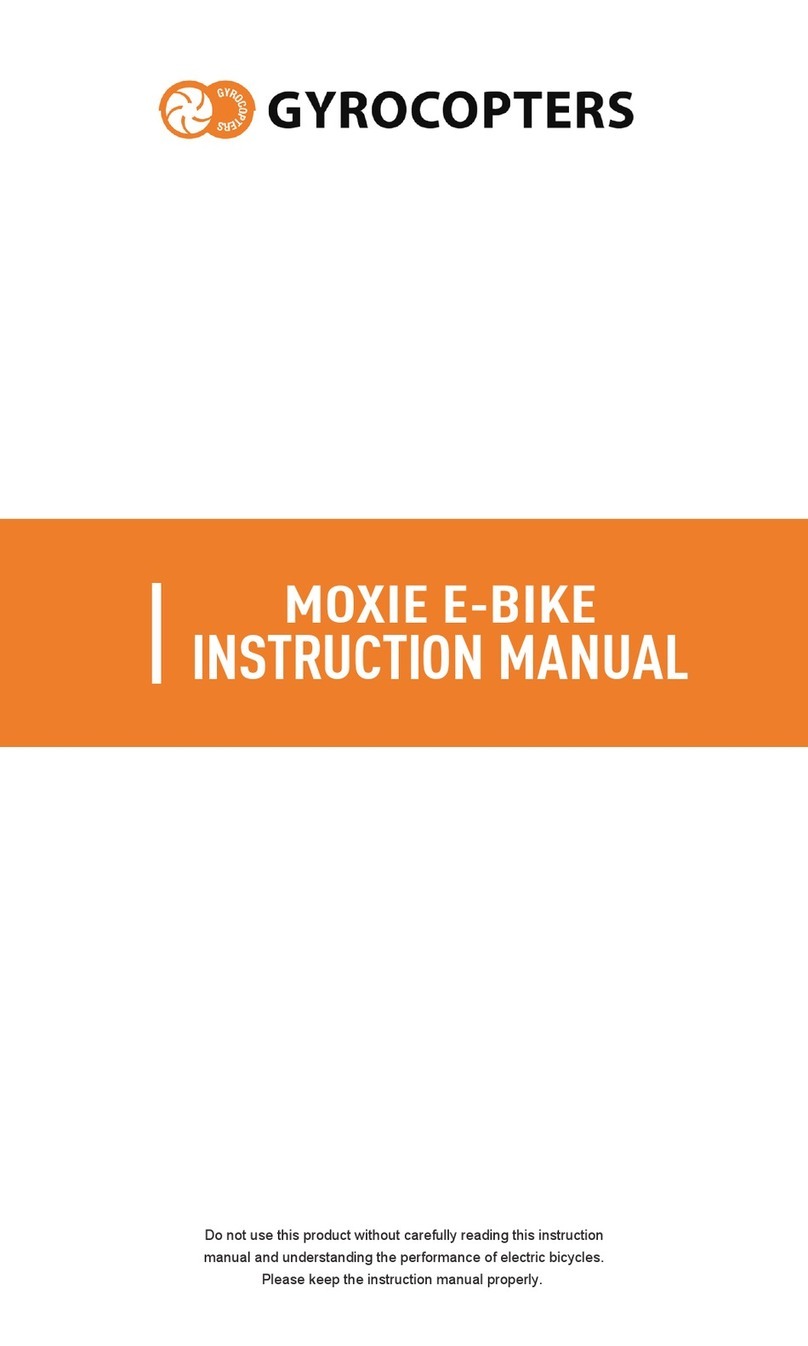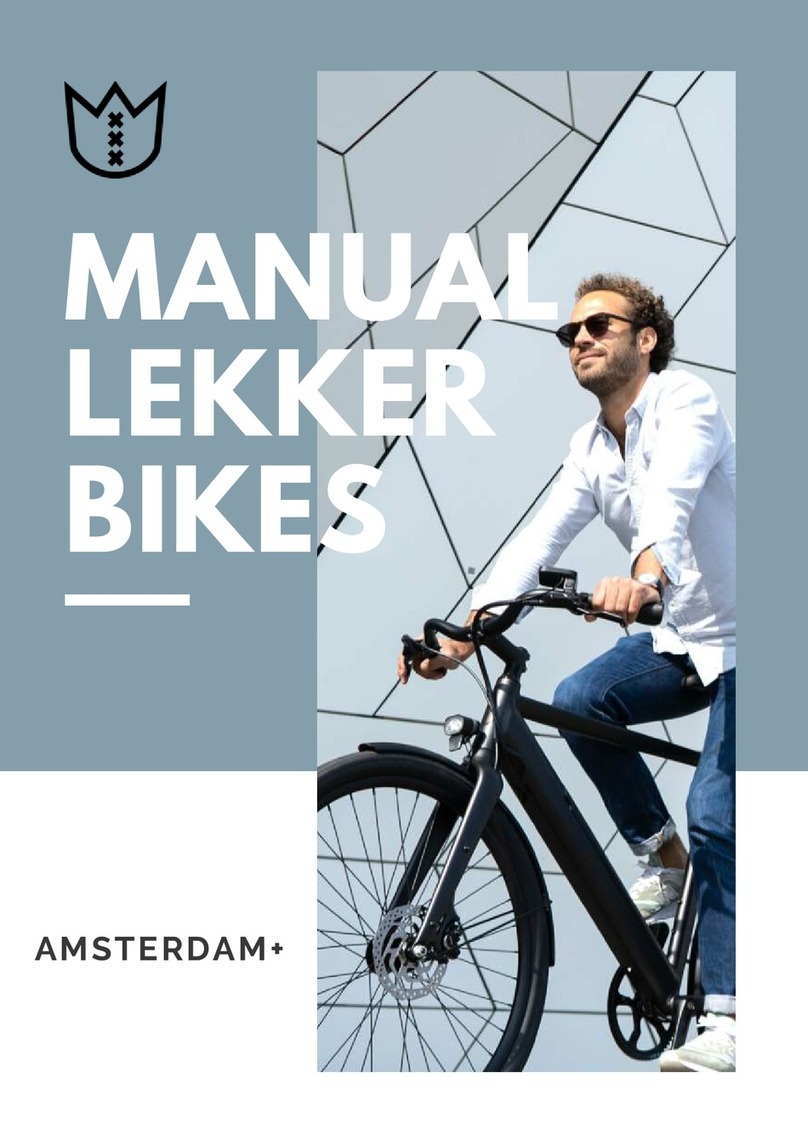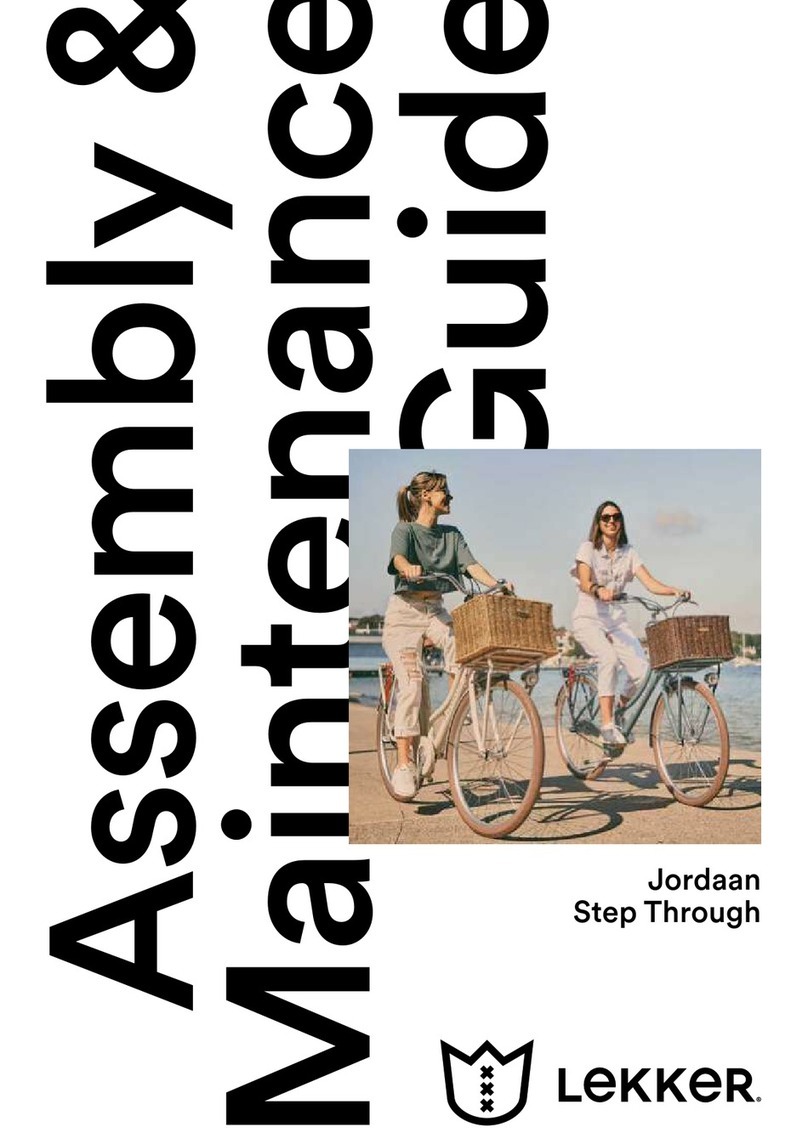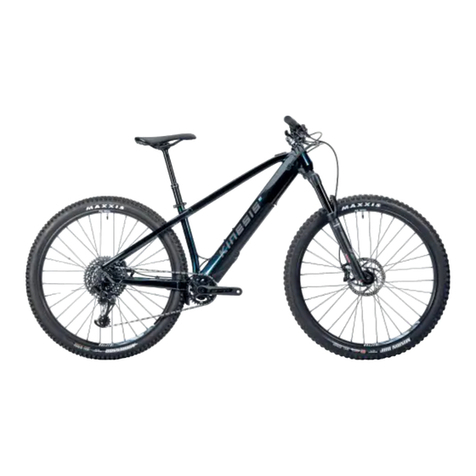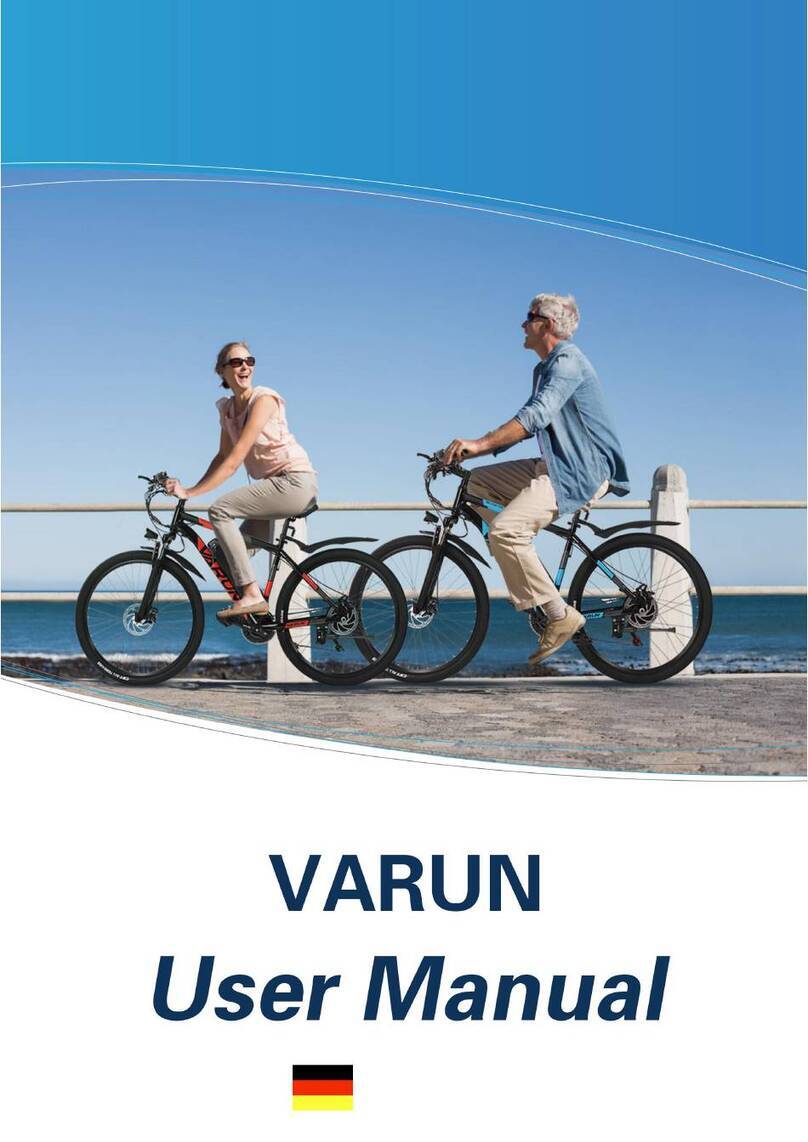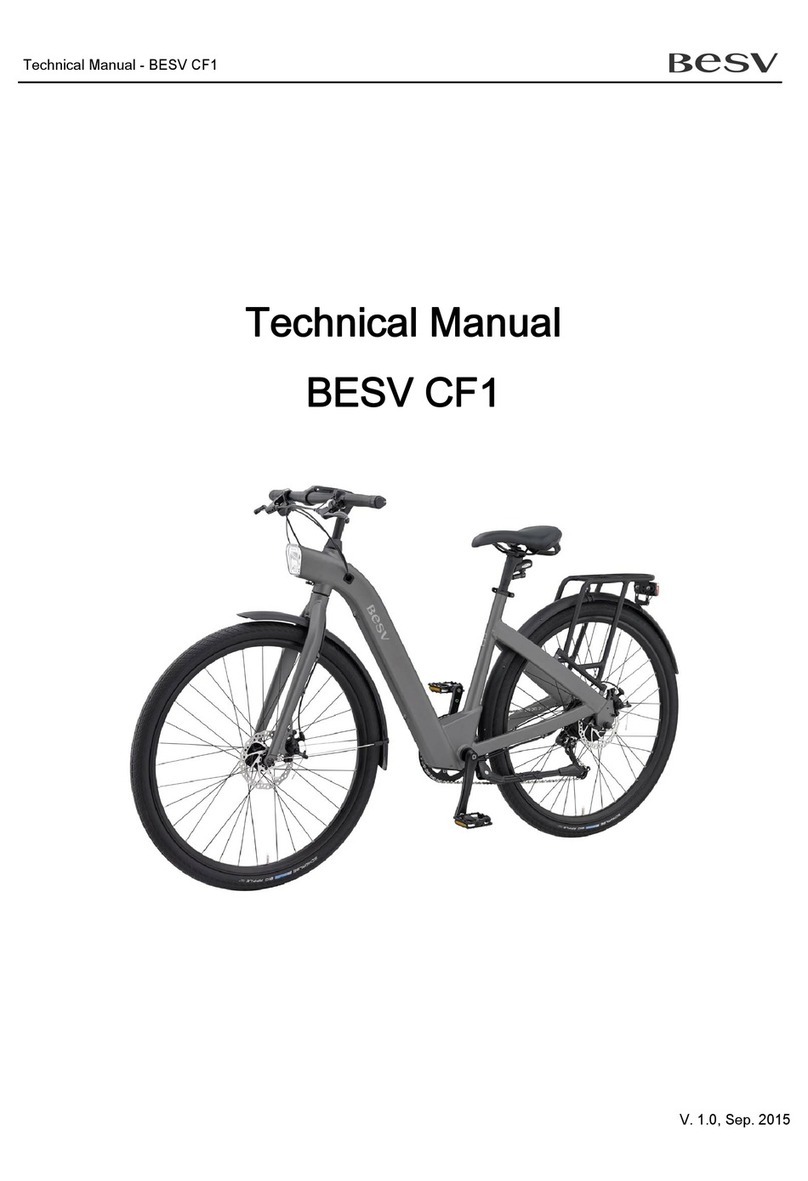BFISPORT EB20-02F User manual


Thank you for choosing a
BFI e-bike.
User Manual

Introduction – EB20-20FATmodel
This bicycle has been designed for a smooth and easy
riding experience.
For this purpose, we combined the best aspects of
motor vehicles with a bicycle that can be used without
a license plate or a driving licence.
Traffic laws and regulations must, of course, always be
respected. Always remember to pay attention to
everybody else on the road.
Please carefully read this manual and keep it in a safe
place for future reference.
Should you sell the e-bike, please do not forget to also
include this manual.
Have a nice ride!
Important!
Write down
immediately
your
key
number.
Replacement keys can only be purchased
by providing the correct key number.

Safety warnings
•
Read and follow all the instruction in the user manual before using the e-bike.
•
Owners of the e-bike must check and obey any local laws applicable to e-bike usage concerning helmet use, speed
limits, and accessible areas.
•
Any bicycle, even the most sturdy and expensive, can become unsafe due to normal wear and tear, falls, transport,
ageing or other external factors.
•
The user is responsible for the safe use of his bicycle. It is therefore important to perform the regular safety checks.
•
Use the bicycle only if it is in perfect mechanical conditions.
•
Conform your riding style to your personal skills and the surrounding conditions.
•
For your personal safety always wear a helmet and proper protective equipment.
•
A helmet may be legally required by local law.
•
Comfortable clothes and athletic shoes are also recommended.
•
Be sure that your clothing or your load will not become entangled with the wheels.
•
After a fall or an accident, always remember to have your bicycle checked by a specialist.
•
Bicycles are safe to use only if yearly checked by a specialist.
•
Unsuitable replacement parts and accessories may render the bicycle unsafe. Always seek a specialist advice.
•
Drive safely and always be fully aware of the fact that bicycles are silent, and their approach often goes unnoticed
by other road users.
•
Riding e-bikes is advisable only to those who can already ride normal bicycles. People who have not been riding
bicycles for a long time, should ride e-bikes in traffic only when they feel confident.
•
Do not modify or tamper with the bicycle in a way that will alter its riding behaviour or speed; should such
modifications be attempted, the manufacturer declines any responsibilities ant the warranty would be void.

Proper use
Bikes with electric engines (E-bikes) are designed to be
used on good surfaces and roads, and they are not
suitable for off-road tracks or leaps.
E-bikes maximum load is of 100 kg, user and cargo
together.
Minimum load is of 30 kg.
Operation
•
When accelerating, the user should assist Pedelec
with his own muscle power. This especially when
a lot of energy is required.
According to present regulations, you will
notice what follows:
•
The assistance will be de-activate automatically at
25 km/h.
•
The power will stop automatically when you stop
pedalling.
•
If the engine does not start when using the e-bike,
seek assistance in a specialized bike shop.

When purchasing
Check the following:
•
Your bicycle has been made ready to be used and has been safely inspected by specialized personnel.
•
The retailer explained you the bicycle functions and the safety checklist.
•
The specialized personnel will adjust the bicycle to suit your body weight.
•
For the most complex parts, request the original instructions.
Before first using the e-bike in traffic or off-road.
•
Perform the safety checklist.
•
Train yourself to drive and brake on a safe surface, first using the rear brake, and then gradually increasing the front
brake. You must be able to brake suddenly without losing control. If the front wheel stops turning the e-bike will
become unstable, and this is why the brakes should be adjusted by an expert.
After 4 weeks or 300 km
•
It is normal that on every bicycle – even the sturdiest or most expensive ones – the first adjustments of brakes,
gear shift, bearings, wheels and bolted connections should be repeated. This is done to prevent breakdowns and
malfunctions.
•
Before first using the bicycle, carefully read these instructions and make sure that the bicycle has been correctly
assembled.
•
Apply the maximum care when driving under the rains, on gravel or smooth roads.
•
The bicycle can be used under the rain without getting damaged. The intellectual components, like the battery and
the engine, should never be immersed directly in water.
•
Never touch the battery terminals with your bare hands, and never try to short-circuit them with a tool.

•
Do not disassemble the electric component but ask for the assistance of a specialist workshop.
•
Do not lend your e-bike to other people without first instructing them.
•
The battery can be damaged by weather.
The top battery efficiency will be obtained above 0°C. When using the battery below 0°C, you must expect a
reduced capacity of about 1/3. However, using the battery below 0°C will not damage it.
Traffic laws
The traffic laws and regulations demand the following (check your local laws too):
1.
When driving at dusk or at night, the bicycle should be equipped with a white frontal light and a rear red light.
The light should not be flashing (check your local laws). The lights should be installed on the bicycle, and not worn
by the cyclist. It is permitted to remove the lights from the bicycle when not used.
2.
Every bicycle should be equipped with front and rear refractors, and on the pedals too, and it is permitted to
install other refractors on the wheels.
3.
Every bicycle should have a bell (check your local laws).
4.
We suggest stipulating an antitheft insurance.
5.
We suggest stipulating a civil liability insurance. Check with your insurance company that your insurance policy
will cover all damages caused by you.
6.
Cyclist should always respect all the traffic laws and regulations (check your local laws).

Safety checklist
Troubleshooting for this section is listed in the next page with the respective number for each action:
1.
Pull the brake levers with all your strength, they should not touch the handlebar.
2.
Pull the brake levers and push the bicycle forward – the brake pads should clench the discs.
3.
Block the front wheel and turn the handlebar – the handlebar should not turn.
4.
The seat should not turn or flip upside-down.
5.
The seat and handlebar can only be extended up to the mark on their respective pole.
6.
Check that the wheel is blocked, the quick release lever should not protrude.
7.
Spin the wheels – they should move aligned and smoothly – without touching any parts in any point.
8.
Let the bicycle fall from 20 cm of height – if the attachments like the luggage carrier, the mudguards or the lights
are moving or clicking, they might be wrongly installed.
9.
Check the lights and the bell.
10.
Check the tyres conditions and pressure, and look for loose spokes.
11.
Check the frame, the handlebar and the forks for cracks o bending.
12.
The brakes and shift cables should not show tears or other signs of damage.
13.
Look for any broken link on the bicycle chain.
14.
Test the brakes and the gearshift good condition with a road test.
15.
Check the electrical engine and the charging level of the battery.

Troubleshooting
Maintenance carried out by unqualified technicians might result in serious accidents:
1.
The screw on the brake levers can be used to adjust the distance between the same levers and the handlebar.
2.
Brakes adjustment should be carried out by an expert.
3.
Most handlebars can be tightened with a screw located in the middle of them. All other adjustment should be
carried out by an expert.
4.
Tighten all the screws around the seat.
5.
The seat and handlebar can only be extended up to the mark on their respective pole.
6.
Properly true the wheel, tighten the nuts, lock the quick release device.
7.
Loosen and true the wheel – the distance from the forks and the frame should be proportioned.
8.
Tighten loose screws. Ask an expert to repair any broken part or screw.
9.
Tighten loose screws, replace the light, fix the cables.
10.
Inflate the inner tube with a hand pump – compressed air might damage the tyres. Ask an expert to repair any
damaged tyre or loose spoke.
11.
Any minor damage to the bicycle should be repaired by qualified personnel.
12.
Damage cables should be immediately replaced by qualified personnel.
13.
Damaged chains should be immediately replaced by qualified personnel.
14.
If the braking is too strong, week or unstable, or if the bike rides irregularly, or if the gearshift does not work
properly, the bicycle should be fixed by an expert.
15.
Seek a qualified service centre to service the electric engine.

Safe driving
•
Use the e-bike only if you are healthy and in good shape.
•
Do not ride the bicycle under the influence of alcohol, drugs or medicines.
•
The e-bike should be calibrated according to the body weight of the rider.
•
Practice riding, braking, shifting gears and turning in a safe way before riding in heavy traffic.
•
Wear gloves in cold weather, so to always be able to grip the handlebar with two hands and apply strength when
braking.
•
Securely set your load in the luggage carrier. Do not hang carry bags on the handlebar, as this can lead to critical
accidents.
•
Please bear in mind that a heavy load will much influence the bicycles behaviour; use purposely built bicycle bags,
which will allow for a lower gravity centre.
•
Bicycles have a longer braking distance than cars, so you must respect the safety distance.
•
The brake distance is further increased on humid, wet or dirty surfaces.
•
Ride with caution, e-bikes do not accelerate quickly! Do not steer abruptly when starting, or you might risk falling.
•
Practice how to quick start before a rise, so to avoid slowing down too much and putting yourself in danger.

How to carry the e-bike
•
To carry your e-bike, secure it vertically on a special bicycle rack on top of your car, so to avoid excessive stress
on the handlebar or other parts.
•
Remove any attachments, such as mudguards, bottles, pumps and similar, as they can be ripped off by the strong
wind.
•
When transporting your e-bike under the rain at high speed, water will get into the bearings and inside the cables,
causing premature damage.
•
To transport the e-bike horizontally inside your vehicle, please make sure that the hub gears are facing upwards,
so to prevent any damage.
•
Perform the safety checklist after any transportation.

Maintenance
•
Every e-bike should be inspected by an expert at least once a year. This inspection should be carried out to find any
hidden damage, like micro-fractures in the frame or handlebar, damaged brake cables, broken rims, used up brake
pads, etc.
•
Make sure you only use suitable and safe replacement parts; especially about brakes, when replacing the pads
make sure that the new ones are suitable for the rims, so that the breaking power complies with the local traffic
laws.
•
In case the controller device shows abnormal behaviour, bring it to a bike shop. Do not attempt do replace the
controller without expert help.
•
Keep both the e-bike and the controller clean and avoid water infiltrations (rain is not a problem).
Do NOT immerse the battery in water. Do not clean with a water pump or a pressure washer, but only with a damp
cloth.
•
Always keep the battery charged, regardless if the bicycle is being used or not.
•
Use only the original battery charger.
•
If you should store the bicycle, remember to regularly recharge the battery at least every two months, to avoid
loss of battery capacity.

•
Store the battery preferably in a dry place at room temperature.
•
The battery should reach its maximum charge capacity after about 10 charging cycles.
•
Do not expose the battery to high temperatures, such as the direct light of the sun in closed vehicles or naked
flames, etc.
•
If after an accident you should find the battery is leaking, you must immediately replace it. Ask your dealer.
•
Batteries must not be disposed of as ordinary waste but must be taken to a special waste collection point, according
to local regulations.
•
Do not overexert the bicycle. This includes using bicycle trailers and riding off-road.
•
On a steep rise, remember to boost the bicycle power with your own strength, to avoid overheating the system. In
case of overheating, a fuse will activate to prevent damage.
•
To save battery power during acceleration, you might want to help by using your own strength.

Cleaning and storage
Cleaning
•
Regularly clean your e-bike; is the best way to find damages.
•
E-bikes should not be cleaned with pressure cleaners, or with steam current or strong water jets. This system might
facilitate sand grains and humidity to get inside the bearings and the cables, thus damaging them prematurely.
•
Clean the e-bike with warm water and a detergent to dissolve grease. You will find all the suitable cleaning products
in a bike shop.
•
Clean the chain and the gears, too. A clean chain, smoothly moving and well lubricated, considerably increases the
lifespan of the gears.
•
After cleaning them, lubricate again the chain and the gear; use a suitable product, resistant to rain.
•
Operational flaws like dirty or corroded parts, especially the chain, are not included in the warranty. Chains are not
immune to rust and should be taken care accordingly.
•
After cleaning and lubricating, remove any residual grease from the rims.
•
Residual grease on the rims may reduce brakes efficiency.

Storage
•
When not in use, the e-bike should be stored in a dry place.
Exposing it to outside weather will highly reduce their lifespan. This why it’s particularly important to protect the
e-bike with a purposely made anti-corrosive coating. This product may be bought by any bike shop.
•
If you do not use the e-bike for a long period, keep it hanging on the wall; this way tyres will be protected from
damage.
•
Clean and set up the e-bike before storing it, and during this period have it checked by a specialised bicycle
workshop.
•
Remember to deactivate the system by switching off the main switch.
•
Even if the e-bike can be used under the rain or in adverse weather conditions, it must be stored indoor or in a
covered space, to avoid humidity from affecting the electric parts and the engine.
•
Also, remember to protect your e-bike from thieves.
When storing the e-bike, remember to recharge the battery at least every two months.

Controller display
There are three buttons on the display.
Power on/off
Press the power-on button to turn-on the display and the bike controller.
Press again the same button to turn-off the display and the controller.
When the e-Bike is not used for more than 10 minutes, the display will automatically turn off (hibernation mode).

Light indicator
The front light is not controlled by the display.
This indicator will never turn on with this product.
Battery
If all lights are on means the battery power is around 80%-100%.
Four light on mean the battery power is around 60%-80%.
Three lights on mean the battery power is around 40%-60%.
Two lights on mean battery power is around 20%-40%.
Just one light on means the battery power is around 0%-20%.
When only one light is on, battery needs to be charged soon.
We suggest stopping soon and charge the battery.
When battery is very low, the icon will turn on.
Please stop immediately and charge the battery.
Brake Indication
Each time you use the brake, this symbol will turn on.

PAS Level
There are five different speed mode.
Motor assistance level: from 1 (17km/h max) to 2 (19km/h max) to 3 (21km/h max) to 4 (23km/h max) to 5 (25km/h).
When the display is turned-on, press “+” and “-“ buttons to select the desired motor assistance level.
The display will show the current motor assistance level.
Push-assistance Mode
To activate the push-assistance mode, the display must be turned-on already.
Press the “-“ button to activate the function: the bike will enter into 6km push-assistance mode.
The display will show the relative symbol.
The bike will move forward.
The push-assistance mode may only be used when the user needs to push by hand the bike.
Danger of injury when the wheels of the eBike do not have ground contact while using the push-assistance function
Pay attention when using this function.
The push-assistance function switches off as soon as you release the “-“ button.

USB port
USB port on the bottom side of the display can be used for charging a device (a mobile phone for example).
Be careful if you use the USB port during the ride.
Running Speed
Real speed.
Measuring unit is set in Km/h by default.
See “Parameter settings” to switch to Mph.
Average Speed
It shows the average speed in Km/h or Mph.
Max Speed
It shows the max speed in Km/h or Mph.

Cruise Function
The function is not set for this model.
This indicator will never turn on with this product.
Motor Failure
This indicator will never turn on with this product.
Wheel Failure
This indicator will never turn on with this product.
Controller Failure
This indicator will never turn on with this product.
Table of contents
Popular Bicycle manuals by other brands

HP Velotechnik
HP Velotechnik Go SwissDrive Operating manual and service instructions

Radio Flyer
Radio Flyer 411 manual
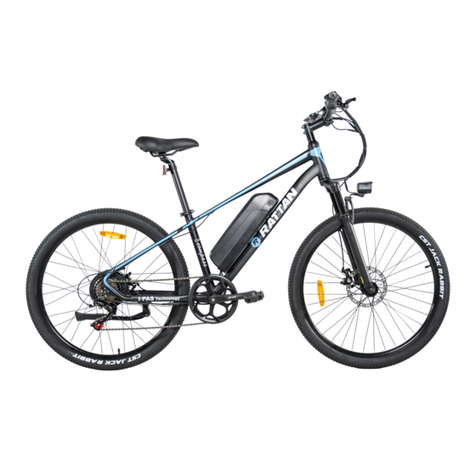
RATTAN
RATTAN COMPASS user manual

Fantic Motor
Fantic Motor INTEGRA 140 TRAIL User and maintenance handbook
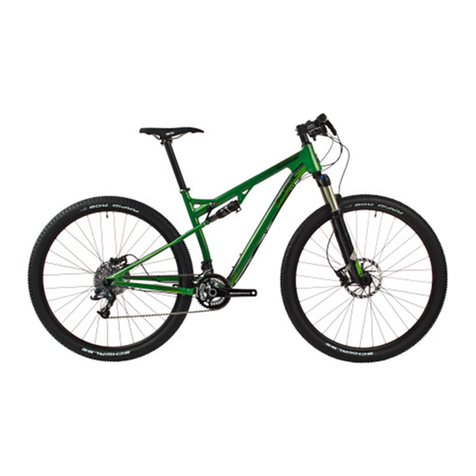
SALSA
SALSA SPLIT PIVOT Horsethief Gen.3 manual
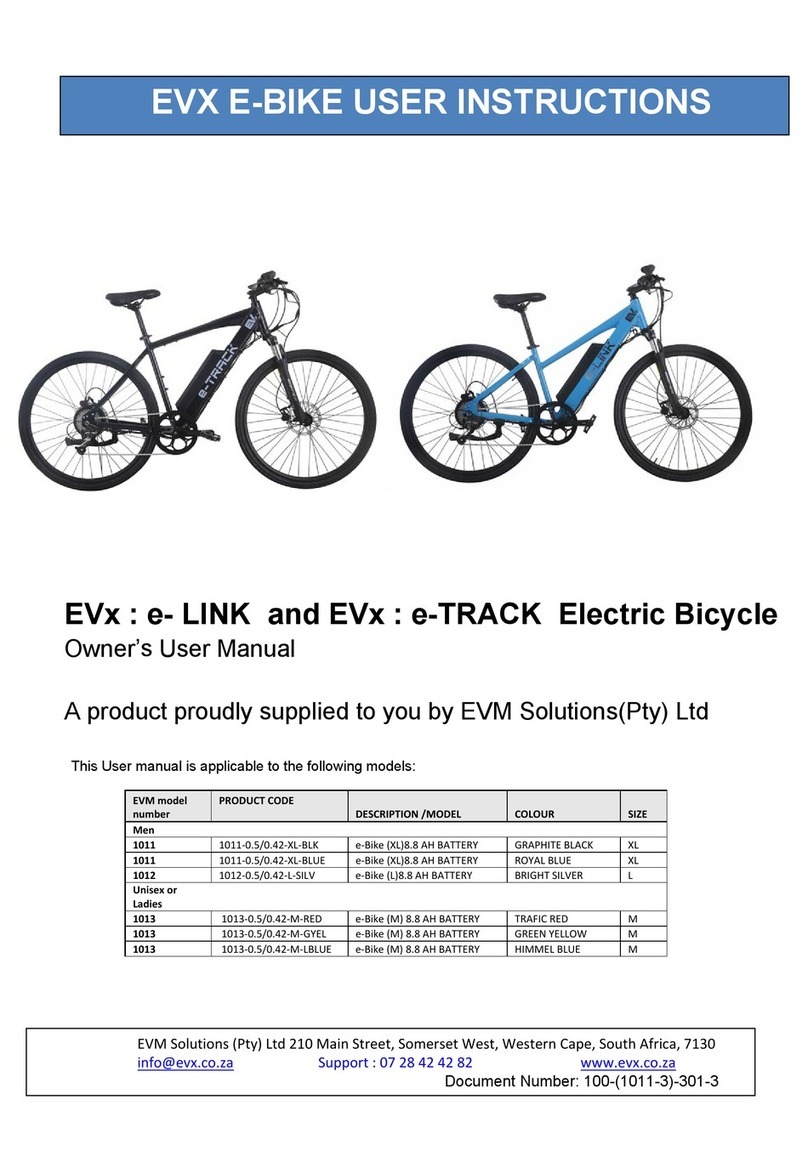
EVX
EVX e-TRACK Series User instructions
